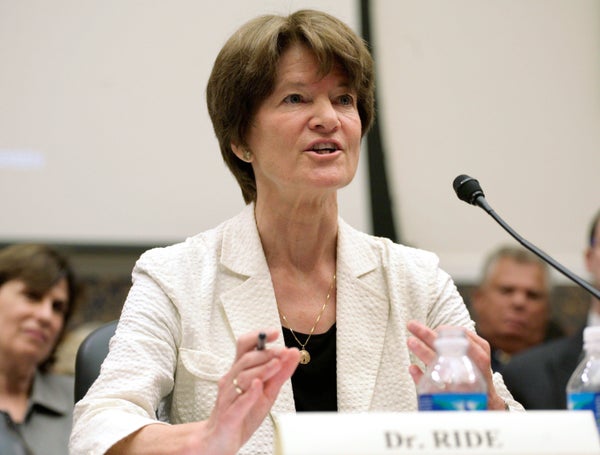The U.S. Mint recently announced the first two women who will be honored on quarters as part of a program to celebrate American women’s achievements: the writer, poet and civil rights activist Maya Angelou and Sally Ride, a “trailblazing astronaut,” as the agency correctly described her. Ride was also a physicist and science communicator whose zeal to get the public and students, particularly girls, more involved in science showed the same steely determination she’d taken into orbit.
I observed Ride’s dedication to science communication up close from 1999 to 2000, when she was president of Space.com, which was founded by the broadcast personality Lou Dobbs, who served as the chair. I was a staff writer and editor there since before the Web publication went live in July 1999, on the 30th anniversary of the Apollo 11 moon landing.
The dot-com boom had brought high hopes that internet start-ups could prove their financial mettle and undertake successful public stock offerings, but as that boom neared its tail end, pressure to generate Web traffic and advertising revenue was high. Dobbs was a notoriously difficult boss, contributing to the heated atmosphere. The company’s first president had stepped down, and Ride was brought in as a replacement, dividing her time between the company’s newsroom in New York City and her physics-teaching responsibilities in California.
On supporting science journalism
If you're enjoying this article, consider supporting our award-winning journalism by subscribing. By purchasing a subscription you are helping to ensure the future of impactful stories about the discoveries and ideas shaping our world today.
Ride was adamant about making sure the company earned respect as a reliable source of science news and information. She put the site’s editors in touch with her science colleagues to double-check the accuracy of articles. The company had taken an eclectic approach to covering space, touching on everything from astronomy to space commerce to science fiction, with a portion of the site catering to the dubious culture of UFO aficionados. Ride ensured that the emphasis would be on science, without credulous reporting on supposed alien phenomena.
Ride also had a notably kind and patient presence, listening intently to employee grievances and staying calm amid the daily Web publishing scramble. I once sent her a memo somewhat caustically discussing whether a sentence on the site should say “memento” or “momento,” and she took my pedantic copyediting in stride. In mid-2000 I resigned from Space.com during a tense staff meeting with Dobbs, at which Ride was not present, and she, too, left the company some months later. Despite the turmoil of the deflating dot-com bubble, Space.com remained operational, unlike many Web ventures at the time. Having undergone changes in structure and ownership, it continues to conduct science journalism along the course Ride charted for it, and it has contributed alumni to various media outlets, including Scientific American. (Space.com is a content partner of Scientific American.)
In 2001 Ride joined three colleagues, as well as her life partner Tam O’Shaughnessy, to found Sally Ride Science, a company dedicated to making STEM education more equitable and inclusive, with a special emphasis on encouraging participation by girls. The company, which became a nonprofit in 2015 under the auspices of the University of California, San Diego, has provided numerous workshops for children, hosted science festivals, published books, and enabled kids to capture images of Earth and the moon taken from space platforms. Sally Ride Science has also provided teacher training and held contests for student teams to compete in developing toys and games.
Ride died of pancreatic cancer in 2012. While she will always be remembered primarily as the first U.S. woman in space and holds the distinction of being the youngest American astronaut to travel to space (at age 32), her work in later decades—raising standards for science communication and education—is as central to her legacy as her two missions aboard the space shuttle Challenger. She was also the only person to serve on both of the committees that investigated the Challenger and Columbia shuttle disasters, which is an additional manifestation of her imperative to provide accurate scientific and technical information to the public.
In 2017 a Lego Women of NASA building set was released, featuring Ride along with astronaut Mae Jemison, computer scientist Margaret Hamilton and astronomer Nancy Grace Roman. The idea was introduced by Maia Weinstock, a science journalist I worked with at Space.com. I believe Ride would have been delighted by this product, as she saw inspiring children as the best possible use of her fame.
The first coins issued under the U.S. Mint’s American Women Quarters Program will be circulating in January 2022. Ride’s image on these quarters will be a fitting tribute to a woman who pioneered knowledge and outreach as well as space.
This is an opinion and analysis article.
